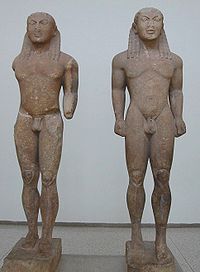- Kleobis and Biton
-
Kleobis (Cleobis) and Biton (Ancient Greek: Κλέοβις, gen.: Κλεόβιδος; Βίτων, gen.: Βίτωνος) are the names of two human brothers in Greek mythology. It is also the name conventionally given to a pair of lifesize Archaic Greek statues, or kouroi, which are now in the Delphi Archaeological Museum, at Delphi Greece. The statues date from about 580 BC and come from Argos in the Peloponnese, although they were found at Delphi.
Contents
In Mythology
In Greek mythology, Kleobis and Biton were Argives, the sons of Cydippe, a priestess of Hera. Cydippe was travelling from Argos to a festival in honor of Argive Hera. The oxen which were to pull her cart were overdue and her sons, Kleobis and Biton, pulled the cart the entire way (45 stadia, or 8.3 km/5.1 miles). Cydippe was impressed with their devotion to her and her goddess and she prayed to Hera, asking her to give her children the best gift a god could give to a mortal. Hera ordained that the brothers would die in their sleep, and after the feast the youths lay down in the temple of Hera, slept and never woke. Herodotus, who relates the story, says that the citizens of Argos donated a pair of statues to the sanctuary of Apollo at Delphi.
Statues
In Book 1 of Herodotus' Histories, Solon tells the story of Cleobis and Biton to King Croesus as an example of a happy life lived, reckoning them second in happiness only to Tellus the Athenian, much to Croesus' annoyance. Herodotus records that "the Argives had statues of them made and set them up at Delphi, because they had been such excellent men". The modern Delphi Museum displays two identical Archaic kouroi under the names of Cleobis and Biton, although there is no evidence directly connecting these statues with the ones mentioned by Herodotus.
Inscriptions on the base of the statues identify them as Kleobis and Biton, and also identify Polymides of Argos as the sculptor: something which was very unusual at such an early date. The statues are in what is regarded as a typical Peloponnesian style: massive and muscular. But they are not intended to be lifelike representations of Kleobis and Biton, even assuming the brothers were historical rather than mythical figures. The statues are ideal representations of the virtues of masculine strength and piety.
See also
- Ancient Greek art
External links
Ancient Greece Periods Geography Politics Rulers - Kings of Sparta
- Kings of Athens
- Archons of Athens
- Kings of Macedon
- Kings of Pontus
- Kings of Paionia
- Roman Emperors
- Kings of Kommagene
- Kings of Lydia
- Attalid Kings of Pergamon
- Diadochi
- Kings of Argos
- Tyrants of Syracuse
Life - Agriculture
- Clothing
- Cuisine
- Democracy
- Economy
- Education
- Festivals
- Homosexuality
- Law
- Marriage
- Mourning ritual
- Olympic Games
- Pederasty
- Philosophy
- Prostitution
- Religion
- Slavery
- Warfare
- Wine
Military - Wars
- Army of Macedon
- Antigonid Macedonian army
- Pezhetairoi
- Hoplite
- Seleucid army
- Hellenistic armies
- Phalanx formation
- Peltast
- Sarissa
- Xyston
- Sacred Band of Thebes
People OthersGroups- Playwrights
- Poets
- Philosophers
- Tyrants
- Mythological figures
CulturesBuildings Arts Sciences Language Writing Lists - Cities in Epirus
- Theatres
- Cities
- Place names
Categories:- Archaic Greek sculptures
- Ancient Argives
- Characters in Herodotus
Wikimedia Foundation. 2010.


